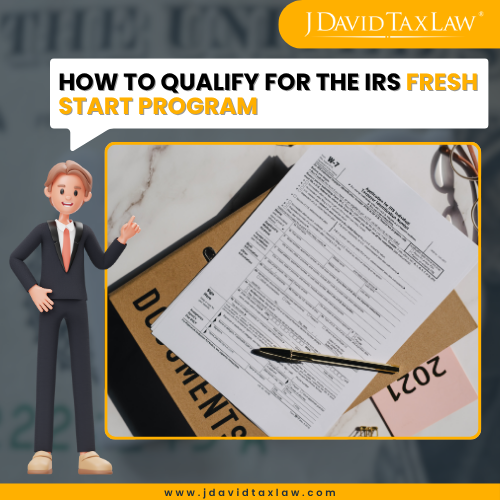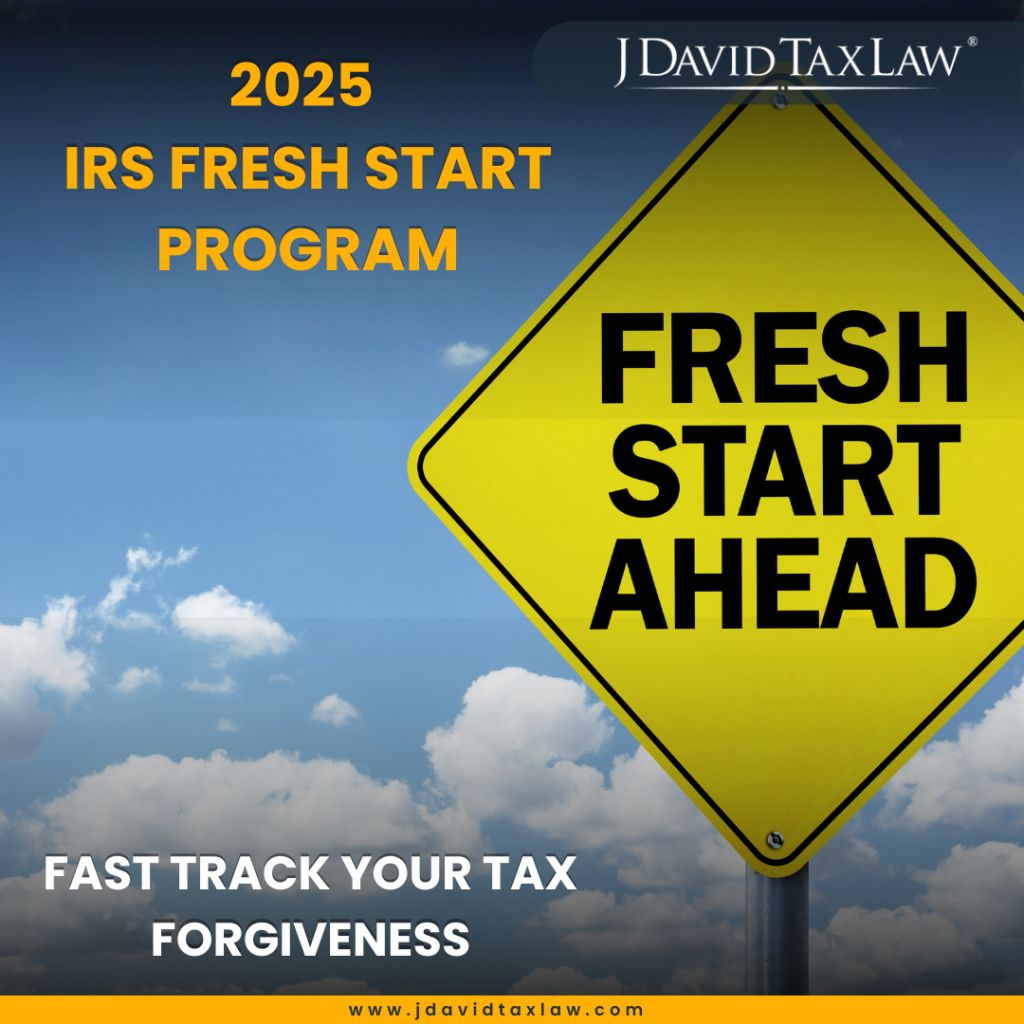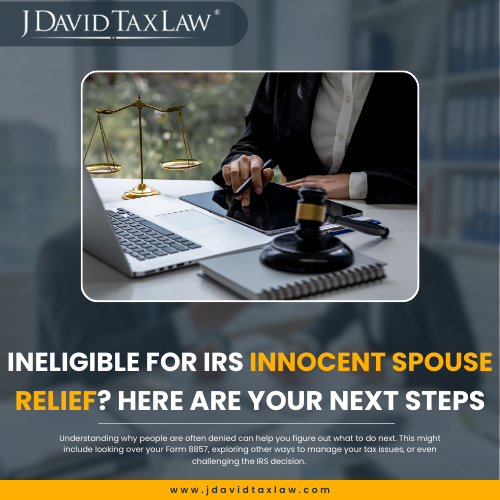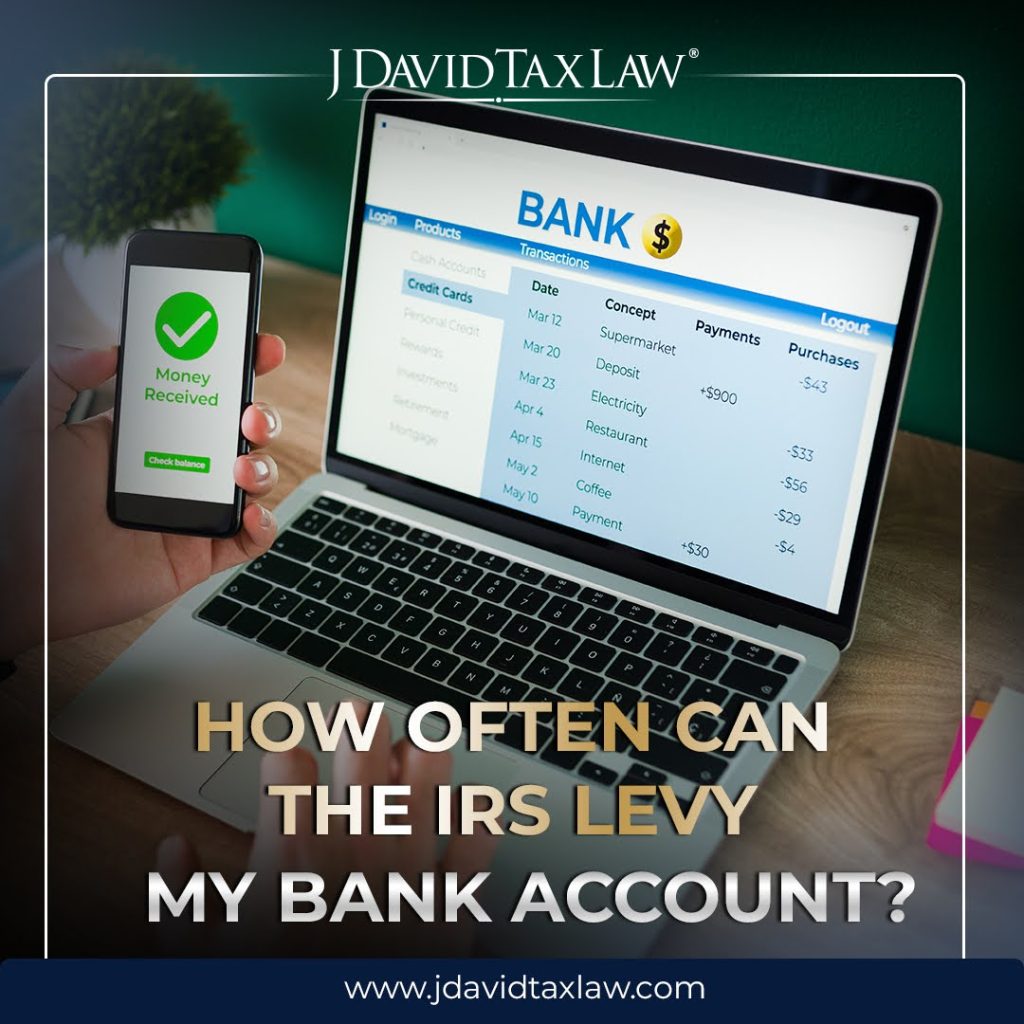If you’re overwhelmed by back taxes, you’re not alone. Millions of Americans face tax debt that feels impossible to manage. Fortunately, the IRS Fresh Start Program offers real relief. Created in 2011, this initiative simplifies how taxpayers resolve unpaid tax bills through expanded installment agreements, penalty relief, and settlement options.
At J. David Tax Law , our experienced tax attorneys help individuals and businesses determine whether they qualify, and how to use the program to reduce or eliminate IRS enforcement actions like liens, levies, and wage garnishments.
What Is The IRS Fresh Start Program?
The IRS Fresh Start Program isn’t a single application or form you fill out. Instead, it’s a series of updated IRS policies and provisions designed to make tax debt resolution more accessible. These revisions empower taxpayers to:
-
Avoid aggressive IRS collection actions like liens and wage garnishments.
-
Establish long-term payment plans that fit their financial situation.
-
Qualify for Offers in Compromise (OIC), which allow for settling tax debt for a reduced amount.
-
Receive penalty relief under specific circumstances, reducing the total amount owed.
Whether you’re a W-2 employee, self-employed, or a small business owner, this program aims to help you resolve your tax debt without the burden of severe IRS enforcement.
The IRS is Forgiving Millions Each Day. You Could Be Next.
General Requirements for Fresh Start Options
Some general requirements apply to all Fresh Start programs:
-
Tax Compliance: You must generally be up-to-date with all tax filings (typically the last three years). If self-employed, all estimated tax payments for the current year must be made. The IRS prioritizes taxpayers who demonstrate a willingness to comply.
-
Financial Hardship: You must show genuine financial difficulty that prevents you from paying your tax debt in full without sacrificing basic living expenses. The IRS will likely ask for detailed financial documents.
-
No Active Bankruptcy: If you’re currently in active bankruptcy, you generally won’t qualify.
-
No Criminal Tax Cases: Taxpayers involved in criminal tax cases or tax evasion/fraud are typically excluded.
If you’re unsure, contact J David Tax Law.
Benefits of the IRS Fresh Start Program
The Fresh Start Initiative offers significant practical and legal advantages, making tax relief more attainable for struggling taxpayers:
-
Avoid Tax Liens for Balances Under $10,000: The IRS increased the threshold for filing a Notice of Federal Tax Lien from $5,000 to $10,000. This change reduces the likelihood of a lien being filed for taxpayers with smaller outstanding debts, protecting their credit and assets.
-
Extended Installment Agreements: For taxpayers who owe $50,000 or less (including tax, penalties, and interest), the program allows for repayment over an extended period of up to 72 months (six years). This offers a manageable monthly payment plan without extensive financial disclosure.
-
Streamlined Qualification: A key benefit for many taxpayers is the streamlined qualification process for certain relief options, particularly for installment agreements under the $50,000 threshold. In these cases, a full, detailed financial disclosure is often not required, simplifying the application and potentially leading to a more affordable repayment plan.
-
Offer in Compromise Enhancements: The Fresh Start Program revised the criteria for Offers in Compromise (OICs) , making it possible for more taxpayers to qualify to settle their tax debt for less than the full amount owed. These enhancements often involve updated income and asset guidelines that more accurately reflect a taxpayer’s true ability to pay.
-
Penalty Relief: The initiative broadened access to penalty relief. Eligible taxpayers may qualify for First Time Penalty Abatement if they have a clean compliance history, or for other forms of penalty forgiveness if they can demonstrate reasonable cause or financial hardship due to serious life events beyond their control.
Who Qualifies for the Fresh Start Program?
While the IRS has broadened access to Fresh Start Program benefits, not everyone is eligible. You may qualify if you meet these general criteria:
You Owe $50,000 or Less
To qualify for a streamlined installment agreement (which requires less financial disclosure), your total IRS debt, including interest and penalties, must not exceed $50,000. If your debt is higher, other options may still be available, but they will likely require more detailed financial documentation.
You’ve Filed All Required Returns
A fundamental requirement for any Fresh Start relief is being fully compliant with your tax filing obligations. Any missing or late tax returns for prior years must be submitted before the IRS will consider granting relief.
You Can Pay Within 6 Years
For a standard streamlined installment agreement under the Fresh Start Program, the tax debt is generally expected to be repaid within 72 months.
You’re Not Under Criminal Investigation
Taxpayers involved in criminal tax fraud or evasion cases are generally not eligible for Fresh Start benefits.
Self-Employed? You Must Be Current on Estimated Payments
If you are self-employed, you must be up to date on your quarterly estimated tax payments for the current tax year to maintain eligibility.
Fresh Start Resolution Tools Explained
Tax attorneys leverage the following strategies under the Fresh Start umbrella to help clients efficiently resolve their tax debt. These tools are the core components of the IRS Fresh Start Initiative:
Expanded Installment Agreements
Installment agreements let you make manageable monthly payments over an extended period. The Fresh Start Initiative significantly expanded access to these agreements, particularly for the “streamlined” option.
Who Qualifies for a Streamlined Installment Agreement?
-
Total Tax Debt: For individual taxpayers, your total tax debt (including tax, penalties, and interest) must be $50,000 or less. For businesses with payroll tax debt, it’s $25,000 or less.
-
Direct Debit Payments: You must agree to make monthly payments via direct debit from your bank account.
-
Payment Term: Payments can be spread over up to 72 months (six years), and in some cases, extended to 84 months.
-
Current on Filings and Payments: You must be up-to-date on all required tax filings and estimated tax payments (if applicable).
-
No Financial Statement Required (Generally): For streamlined agreements, the IRS typically doesn’t require a detailed financial statement (Form 433-F), simplifying the application.
Benefits:
-
Avoid Aggressive Collections: The IRS typically won’t take enforcement actions like wage garnishments or bank levies once an agreement is approved and payments are on time.
-
Manageable Payments: Spreading out the debt makes it more affordable.
-
Prevent or Withdraw Tax Liens: Can prevent new liens and, in some cases, lead to withdrawal of existing liens (if balance under $25,000 and three direct debit payments have been made via direct debit).
Considerations:
-
Interest and Penalties Still Apply: These continue to accrue on the unpaid balance until the debt is paid in full.
-
Default Risk: Missing payments or failing to remain compliant with future tax obligations can lead to the default of your agreement.
How to Apply:
-
You can apply online via the IRS website’s Online Payment Agreement (OPA) tool.
-
You can also submit Form 9465, Installment Agreement Request.
-
For debts over $50,000, a non-streamlined agreement may still be possible, but it will likely require a detailed financial statement (Form 433-F or Form 433-A/B).
Offers in Compromise (OIC)
An Offer in Compromise (OIC) allows certain taxpayers to settle their tax debt with the IRS for less than the full amount owed. This option is generally reserved for those facing significant financial hardship.
Who Qualifies for an Offer in Compromise?
The IRS primarily focuses on your “Ability to Pay,” determined by your “Reasonable Collection Potential” (RCP). This includes:
-
Income: Your current and future earning potential. Fresh Start changes mean the IRS primarily considers current income and assets for OICs.
-
Expenses: Your necessary living expenses, with expanded “Allowable Living Expense” standards.
-
Asset Equity: The equity you have in your assets (e.g., real estate, vehicles, bank accounts).
-
Demonstrated Inability to Pay: You must genuinely show that paying in full would create undue financial hardship.
-
Compliance with Filings and Payments: You must have filed all required returns and made all estimated tax payments (if applicable), and not be in active bankruptcy.
-
No Prior Non-Compliance: A history of rejecting previous payment agreements or failing to comply with past agreements can negatively impact eligibility.
Benefits:
-
Significant Debt Reduction: Can substantially reduce your total tax liability, offering a true “fresh start.”
-
Collection Activity Halted: Most collection actions are suspended while your OIC is pending.
-
Tax Lien Removal: Liens can be released once an OIC is accepted and all terms are met.
Considerations:
-
Difficult to Obtain: Many applications are rejected due to thorough scrutiny.
-
Complex Application Process: Requires extensive financial documentation.
-
Non-Refundable Fee and Initial Payment: An application fee (currently $205) and an initial payment are non-refundable, even if denied.
-
Public Record: Some OIC details may be public.
-
Default Risk: Failing to meet terms can reinstate the original debt.
How to Apply:
-
Use the IRS Offer in Compromise Pre-Qualifier Tool on its website.
-
Complete Form 656, Offer in Compromise, and Form 433-A (OIC) for individuals or Form 433-B (OIC) for businesses.
-
Gather all supporting financial documentation.
Tax Lien Thresholds and Withdrawal Options
A federal tax lien is the government’s legal claim against your property for unpaid tax debt, severely impacting your credit. Fresh Start made important changes:
-
Higher Tax Lien Threshold: The IRS generally won’t file a Notice of Federal Tax Lien for tax debts under $10,000 (up from $5,000).
-
Tax Lien Withdrawal: Easier to withdraw a lien if:
-
You enter a direct debit installment agreement with a balance under $25,000 (after three direct debit payments).
-
Withdrawal facilitates tax collection.
-
Withdrawal is in your and the government’s best interest.
Benefits:
-
Improved Credit Score: Lien withdrawal can significantly improve your credit.
-
Access to Credit: Makes it easier to secure loans.
-
Peace of Mind: Reduces financial stress.
Considerations:
-
Not Automatic: You must specifically request withdrawal using Form 12277.
-
Compliance is Key: You must remain compliant with your payment agreement and future tax obligations for the withdrawal to remain in effect.
Penalty Abatement
The IRS imposes various penalties for non-compliance. Fresh Start offers relief in certain situations.
Who Qualifies for Penalty Abatement?
-
First-Time Abatement (FTA): Often the easiest penalty to get removed. You may qualify if:
-
You have a clean compliance history for the preceding three tax years.
-
You’ve filed all required tax returns or extensions.
-
You’ve paid, or arranged to pay, any tax due.
-
Reasonable Cause: You can show unforeseen circumstances beyond your control, such as serious illness, natural disaster, inability to obtain records, or erroneous advice from the IRS or a tax professional (if relied upon in good faith).
-
Statutory Exception: Some penalties have specific legal exceptions.
Benefits:
-
Reduced Overall Debt: Significantly lowers your total tax debt.
-
Financial Relief: Provides much-needed breathing room.
Considerations:
-
Interest Still Accrues: Interest continues to accrue on the unpaid tax balance.
-
Not Guaranteed: Requires strong justification.
-
No Income Qualifications: Focus is on the reason for non-compliance.
How to Apply:
-
For First-Time Abatement , you can often request it over the phone with the IRS or by sending a written request.
-
For Reasonable Cause abatement, you typically send a written request explaining your circumstances with supporting documentation.
-
You can also use Form 843, Claim for Refund and Request for Abatement.
Currently Not Collectible (CNC) Status (Hardship Status)
Currently Not Collectible (CNC) status is a temporary measure the IRS can grant to taxpayers facing severe financial hardship who cannot pay their tax debt without compromising basic living expenses.
Who Qualifies for CNC Status?
-
Demonstrated Inability to Pay: You must prove your current income and assets are insufficient to cover essential living expenses and make tax debt payments. The IRS will review your financial situation meticulously, typically requiring Form 433-F.
-
Compliance with Filings: You must be current on all required tax filings.
-
No Ability to Liquidate Assets: You cannot have easily convertible assets that could be used to pay your tax debt.
Benefits:
-
Temporary Halt to Collection: All collection activities are paused, providing immediate relief.
-
Time to Regain Financial Footing: Allows you to improve your financial situation without constant pressure.
Considerations:
-
Debt Still Exists: CNC status delays collection ; interest and penalties still accrue.
-
Periodic Reviews: The IRS will periodically review your financial situation (typically annually or every two years) to see if circumstances have improved.
-
Tax Lien May Still Be Filed : A lien may still be filed to protect the government’s interest, even while collections are paused.
How to Apply:
-
You generally need to contact the IRS directly and provide detailed financial information (often by completing Form 433-F, Collection Information Statement). The IRS will then review your situation.
How to Apply for the IRS Fresh Start Program
Applying for relief under the Fresh Start Program typically follows these steps:
-
Review Your IRS Account: Begin by ordering your IRS tax transcripts to accurately identify all outstanding balances, confirm your filing status, and understand the scope of your tax debt.
-
Ensure Compliance: File any and all outstanding tax returns. Being fully compliant with your filing obligations is a prerequisite for most Fresh Start options.
-
Determine Eligibility: Conduct a thorough review of your income, expenses, and assets. This will help determine which Fresh Start option (or combination of options) is the most suitable and achievable for your specific financial situation.
-
Submit the Appropriate Forms: Based on your eligibility and chosen resolution path, you’ll need to submit the correct IRS forms. These may include Form 9465 (Installment Agreement Request), Form 433-A/B (Offer in Compromise application), Form 843 (Claim for Refund and Request for Abatement for penalties), or Form 433-F (Collection Information Statement for CNC status).
-
Get Professional Representation: Working with an experienced tax attorney from J. David Tax Law significantly improves the accuracy of your application, increases your approval odds, and leads to more favorable negotiation outcomes with the IRS.
If this feels overwhelming, call (888) 342-9436 to and get a tax attorney on your side today.
Can You Qualify If You Owe Over $50,000?
Yes, even if your tax debt exceeds the $50,000 streamlined installment agreement threshold, you may still qualify for other Fresh Start options or a non-streamlined installment agreement. However, additional steps and considerations are required:
-
Submit Full Financial Disclosures: You will need to provide comprehensive financial documentation by submitting Form 433-A (for individuals) or Form 433-B (for businesses). This detailed disclosure allows the IRS to fully assess your ability to pay.
-
Be Prepared for Additional IRS Scrutiny: Cases involving higher debt amounts often receive more in-depth review from the IRS.
-
Possibly Make a Down Payment: In some situations, making an initial down payment to reduce your balance to below the $50,000 threshold can make you eligible for streamlined options.
Our attorneys regularly assist clients with six-figure tax liabilities and possess the expertise to negotiate favorable payment plans or settlements, even when the debt extends beyond standard thresholds.
Common Misconceptions About the Fresh Start Program
Understanding the truth behind common myths can help you approach the Fresh Start Program with realistic expectations:
Myth: The program eliminates all tax debt.
Fact: The Fresh Start Program offers powerful tools to reduce debt through settlements (like an OIC) or restructure payment plans. However, full forgiveness is rare and is only granted under strict financial hardship criteria.
Myth: You don’t need to be current with your filings.
Fact: The IRS prioritizes compliance. They will not offer relief to taxpayers with missing or unfiled tax returns. Being fully compliant with your filing obligations is a fundamental requirement.
Myth: Anyone can get an Offer in Compromise.
Fact: While the OIC is a valuable tool, it’s not a universal solution. The IRS rigorously reviews your income, equity in assets, and allowable expenses to determine your true ability to pay. Not everyone qualifies, and a strong application is essential.
J. David Tax Law Can Help
With a nationwide team of dedicated tax attorneys, J. David Tax Law brings decades of IRS negotiation experience to the table. Whether you’re looking for help with an IRS installment agreement, an Offer in Compromise, or penalty relief, our tax law firm offers free consultations and a proven track record of results.
Services We Offer:
-
Fresh Start Eligibility Review
-
Installment Agreement Negotiation
-
Penalty Abatement Requests
-
Wage Garnishment Release
-
IRS Audit Defense
-
Tax Return Compliance & Filing
-
Currently Not Collectible Status Requests
-
IRS Appeals Representation
Ready to Take the First Step?
If you owe back taxes and don’t know where to begin, the IRS Fresh Start Program might be the solution you need.
Don’t let tax debt keep you from moving forward.
Contact J. David Tax Law today for a free, no-obligation consultation and discover what relief options are available for you.





















